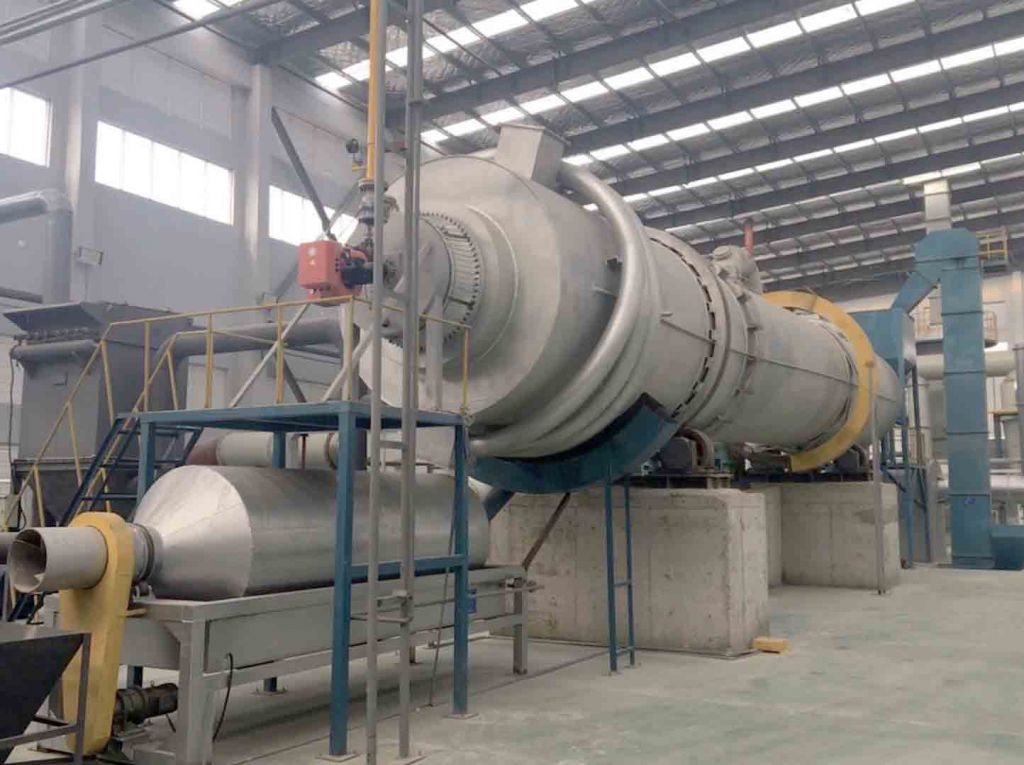Product Description
Biomass carbon-vapor co-production is the process of producing
carbonized materials and vapor with biomass materials, in which
materials are heated in an air-isolation environment to reduce
content of elements other than carbon. Main structure of the plant
consists of a material bin, an elevator, a feeder, a furnace stack,
refractories, a rotator, a temperature detector, a PLC cabinet, a
cooler, a settling chamber, a waste heat boiler, a fan, and a
deduster.
The carbonization process is an integration of material
carbonization and vapor production based on end gas therefrom.
Carbonization Process
The carbonization process is actually a destructive distillation
process at low temperature, in which materials are heated in a
low-temperature and air-isolated environment to volatilize low
molecular compounds, and then trigger a series of complicated
physical and chemical changes in materials, which involves physical
changes such as dehydration, degasification and drying. The process
causes materials to discharge oxygen, hydrogen and other non-carbon
substances, and recombine into substances in ordered graphite
microcrystalline structure. Gaps among microcrystalline in these
crystals formed with irregular hexagon carbon atomic planes are
initial pores of the carbonized materials. Therefore, purposes of
carbonization are changing materials into secondary pore structures
adapted to activation, and rendering them with mechanical hardness
required for undergoing the activation.
Requirements on carbonization of materials are obtained through
carbonization.
Appearance of carbonized materials shall meet requirements in
dimension
and shape. Inner structure of carbonized materials shall offer
specific initial pores
and high mechanical hardness. The carbonization process may be
divided into
the following sections.
(1) Drying section at a temperature below **0°C. External and
internal
moisture of materials evaporate in external heat, and shape of
materials
remains.
(2) Pyrolysis section at a temperature between ******0°C.
Materials
decompose and release gaseous products (CO, CO2, H2 S, etc.),
changes of
chemical composition of material initiates. Pyrolysis temperature
varies with
specific materials, which is lower for low- metamorphic grade
materials.
(3) Carbonization section at a temperature between
*******0°C.
Polycondensation and thermolysis cause materials to separate
volatile
components out. The majority of tar, methyl alcohol, ethylene and
other
products are separated in this section. Materials are gradually
softened and
melted in this section, forming a plastic mass mixed by gas, liquid
and solid
substance, which will be converted into semi- cokes in needle-shape
or bulk.
Constant temperature and heating rate are key operable
conditions
for carbonization process.
Heating rate is critical for productive ratio of carbonized
products.
A high heating rate can separate out more tars and coal gas, and
thereby
reduce productive ratio of carbonization. A lower heating rate may
prolong
the duration of materials in low-temperature section, offering more
options of
pyrolytic reactions which break weaker bonds in molecular in
initial pyrolysis,
and form structures with higher thermal-stability in parallel
sequential thermal
polycondensation, and thus reduce volatile productive rate of
pyrolysis in
the high-temperature section, and achieve higher productive rate of
solid
carbonized products (carbonized materials).
Quality of carbonized materials output from carbonization process
shall
be evaluated considering volatiles content, moisture content and
hardness.
Qualified carbonized materials shall be with a volatiles content of
*2%- *6%,
a moisture content of *5%**5%, and a ball-pan hardness of *0%.
As measurements of the above indexes are time-consuming, and
immediate evaluation on carbonized materials are required in
on-site debugging
for further adjustments on parameters, visual inspection and
evaluation are
acceptable. Qualified carbonized materials shall have smooth and
crack- free
surfaces, high hardness and uniform sections.
Treatments on End Gas and Generation of Vapor with Waste Heat
Carbonized end gas of the carbonization process consists of
high-temperature heating gas generated from combustions of external
fuels,
which including CO2. H*0, N2 and a trace of SO2 and CO, and
volatiles
generated from thermal decompositions, which including CO, H2, CH4,
alkane,
olefin and tar. Traces of toxic matters in end gas of carbonization
may cause
contamination without proper treatments.
With the burning method, end gas from carbonization are transfused
into
a settling furnace at a high-temperature (******0°C) environment
with excess
air, in which combustible gases and toxic substances will be burnt
into CO2
and dumped. Heat generated by the such combustions may be recycled
by the
waste heat boiler for vapor production. It is a low-cost simple
method which
could eliminate most of environmentally harmful substances, and
generate vapor
required for carbonization, therefore, the method is widely used in
production of
activated carbons.
A large amount of vapor could be produced with the heat generated
by
fume combustions.
| Country: |
China |
| Model No: |
Justfine-1002
|
| FOB Price: |
(Negotiable)
Get Latest Price
|
| Place of Origin: |
- |
| Price for Minimum Order: |
- |
| Minimum Order Quantity: |
1 Set |
| Packaging Detail: |
- |
| Delivery Time: |
- |
| Supplying Ability: |
- |
| Payment Type: |
- |
| Product Group : |
- |

